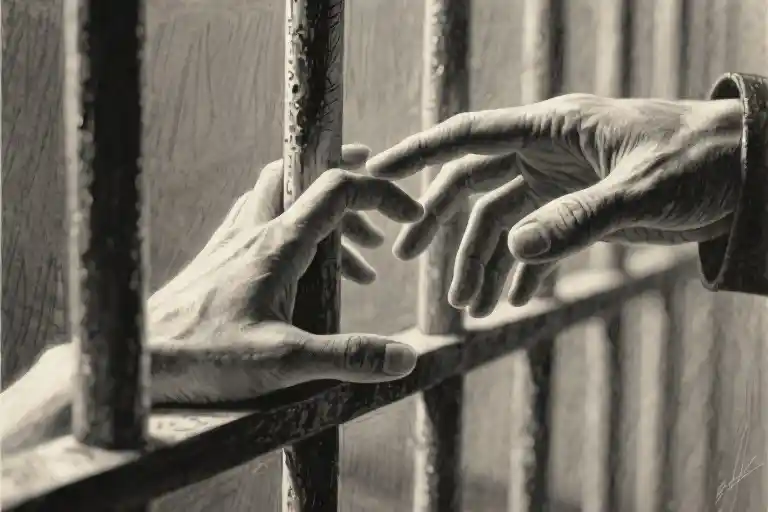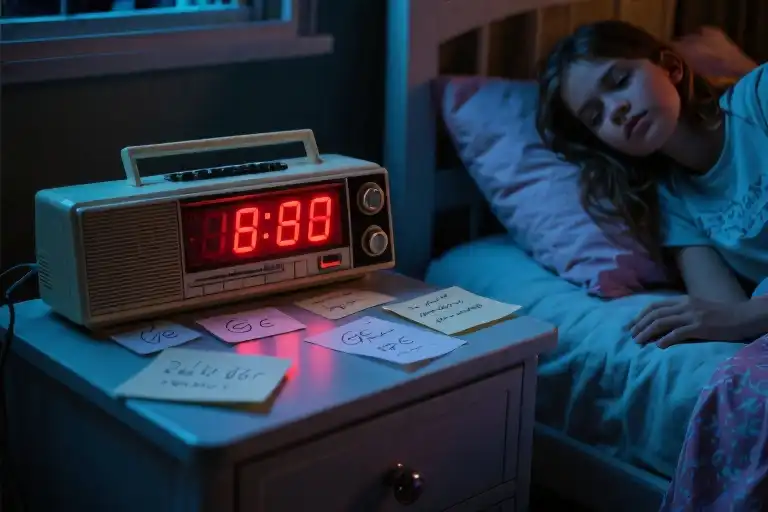The fluorescent lights hummed overhead, casting a sterile glow over the execution chamber. The sharp scent of antiseptic mixed with the faint metallic tang of the gurney’s restraints. Leather straps creaked as Ramiro Gonzales shifted slightly, his chest rising and falling beneath my palm. I could feel his heartbeat – steady at first, then gradually slowing as the chemicals began their work.
It wasn’t the role I’d imagined when I first crossed the Canadian border into Texas years ago. My hand, meant for comforting the sick in hospital wards, now rested on the chest of a dying man by judicial decree. The contrast between the medical setting and its purpose struck me with visceral force – this room designed to end life rather than preserve it.
Ramiro’s skin felt warm beneath my fingers, the pulse in his carotid artery fluttering like a trapped bird. The IV lines running from his arms to the unseen execution team reminded me of hospital dialysis machines, though these tubes carried no salvation. His breathing shallowed as the pentobarbital took effect, each exhalation carrying words we’d exchanged over a decade of visits – about art, about remorse, about the child he’d been and the man he’d struggled to become.
‘You’re not who you were at eighteen,’ I’d told him during our last conversation. His eyes, usually bright with introspection, had clouded. ‘But the state only sees that boy,’ he’d replied. Now, as the heart monitor flattened its peaks into a relentless line, I understood the terrible finality of that truth.
Outside the chamber, Texas justice would call this closure. But as Ramiro’s chest stilled beneath my hand, I felt only the opening of deeper questions about redemption, about systems that judge souls in snapshots rather than lifetimes, about what it means when a government kills a man who’d learned not to kill. The weight of that moment would linger long after the warden pronounced the time of death – not just in my memory, but in the very fibers of my palm where his fading warmth had imprinted itself like an invisible brand.
The Boy Who Killed
The courtroom transcripts from 2006 tell a brutal story in sterile legal language. Ramiro Gonzales, then an 18-year-old with a ninth-grade education, stood accused of kidnapping two women from a convenience store parking lot in Bandera County, Texas. The documents detail how he raped both victims before murdering one – Bridget Townsend, a 19-year-old whose body wouldn’t be found for nearly two years.
Local newspaper archives from that era reveal a community’s outrage. The San Antonio Express-News ran headlines like “Teen Charged in Brutal Murder” alongside Bridget’s high school graduation photo. Her family gave one anguished statement to reporters: “No punishment could ever match what he took from us.” The second survivor, whose identity remains protected, testified about the psychological scars that persisted through her twenties.
What these records don’t show is the context behind the crimes. Buried in child welfare files were warning signs: a mother addicted to methamphetamine, seven different foster homes before age 12, his first juvenile arrest at 13 for stealing food. A court-ordered psychological evaluation noted he’d been sexually abused by an older cousin but received no counseling.
Yet when I first met Ramiro in 2014 – eight years after his conviction – the man who handed me a handwritten poem through the prison glass bore little resemblance to the monster described in those documents. His voice shook as he asked, “Do you think someone like me could ever create something beautiful?” The question hung between us, heavy with implications about redemption, punishment, and whether people can truly change.
This tension between the violent teenager in the court records and the introspective adult I came to know forms the central paradox of Ramiro’s story. The same hands that committed horrific acts would later sketch delicate portraits of fellow inmates’ children from photographs. The mouth that once spewed threats learned to recite Rumi’s poetry by heart. As one prison chaplain told me, “We claim to want rehabilitation, but we refuse to believe it when we see it.”
Transitioning to the next chapter requires sitting with this discomfort – the demon in the archives versus the man who carefully folded each drawing before mailing it to me. Perhaps no single narrative can hold both truths, just as no justice system has yet found how to weigh irrevocable harm against demonstrable change.
The Man Who Drew Sunflowers
The first time Ramiro showed me his sketchbook, the guard hesitated before passing it through the bars. Spiral-bound pages filled with charcoal smudges and colored pencil landscapes slid across the metal table between us. When I turned to a particular page, sunlight from the high windows caught the pigment just right – three sunflowers stretching toward an unseen light source, their petals rendered in obsessive detail against the crosshatched shadows of prison bars.
‘That one took six months,’ he said, tapping the edge where he’d signed his name and inmate number. ‘The guards only let me have yellow pencils twice a year.’ The flowers leaned at impossible angles, their stems twisted yet unbroken. Later, I’d learn he’d drawn them from memory after seeing a Van Gogh reproduction in a donated art book.
The Language of Redemption
Death row art programs remain controversial, but the psychological transformation they facilitated in Ramiro was measurable. His early drawings mirrored the violence of his crimes – jagged lines, distorted figures, pools of red bleeding through cheap paper. The shift toward still lifes and landscapes coincided with his participation in restorative justice workshops. A 2018 prison psychologist’s evaluation noted: ‘Subject demonstrates marked decrease in aggressive ideation correlating with artistic output.’
His most poignant works weren’t the showpieces administrators sometimes displayed for visiting politicians. They were the quick sketches he’d slip to struggling inmates – a dove for a man who’d lost his mother, a mountain vista for someone who’d never traveled beyond county lines. ‘You deserve beauty even here,’ he’d tell them, echoing the words his own art teacher had once said.
Mentorship Behind Bars
By his final year, Ramiro had become an unofficial counselor for younger inmates. I witnessed one such session through plexiglass: a tattooed twenty-year-old shaking as he described his crime, while Ramiro listened with the patience of someone who’d walked that path.
‘You’re not your worst mistake,’ he said, pushing a folded drawing across the table. ‘But pretending it didn’t happen is another crime.’ The kid unfolded the paper to reveal two hands – one holding a knife, the other cradling a seedling. Beneath it, Ramiro had written: ‘Being worthy of love doesn’t mean being innocent. It means choosing what grows from the wreckage.’
These moments never appeared in court appeals or parole board hearings. The system had no checkbox for ‘taught a man to read using poetry’ or ‘prevented three suicide attempts.’ Yet the corrections officers who’d known him longest would sometimes bend rules, allowing extra drawing time when his work calmed entire cell blocks.
The Unmeasured Transformation
Prison rehabilitation programs rarely track the ripple effects of one inmate’s change. But I have the letters – from a man who credits Ramiro’s tutoring with helping him earn a GED, from a grandmother who received his handmade Christmas cards after he befriended her grandson. The warden himself once admitted, off-record: ‘We execute the person they were, not the person they became.’
That last visit, Ramiro gave me his final sunflower drawing. The petals now curled inward, protecting the seeds. ‘They won’t let me plant anything,’ he said, tracing the graphite shading. ‘But maybe this can grow somewhere else.’
These transformations never appeared on the state’s evaluation forms. The parole board never asked about the men who called him ‘Brother,’ the waiting list for his sketches, or how violence decreased on his tier after he started art lessons. The system that meticulously documented his crimes had no language for his redemption.
The System That Made Both
The fluorescent lights of the execution chamber cast sterile shadows across Ramiro’s face as the lethal injection began its work. My palm registered the gradual slowing of his heartbeat through the thin prison jumpsuit – a rhythm that would soon still forever. In that clinical space smelling of antiseptic and fear, an incongruous memory surfaced: a child welfare report from 1992 noting four-year-old Ramiro’s tremors during a methamphetamine withdrawal episode.
Fractured Foundations
Child Protective Services files reveal a childhood scripted by systemic failures. Born to a heroin-addicted mother in rural Texas, Ramiro cycled through twelve foster homes before his sixteenth birthday. Caseworkers documented:
- Age 6: Found alone in motel room for 72 hours with only cereal to eat
- Age 9: Suspended from school for biting a classmate – later attributed to undiagnosed PTSD
- Age 14: First juvenile detention for stealing food, where guards noted ‘unusual tolerance for pain’
Dr. Eleanor Whitmore, forensic psychologist specializing in trauma responses, explains: “Children raised in chronic survival mode develop neurological adaptations. The amygdala becomes hyperactive while prefrontal cortex development lags – essentially creating brains wired for threat detection but poor impulse control.” Her research shows 78% of death row inmates share similar adverse childhood experience (ACE) scores of 7 or higher.
The Poisoned Well
Ramiro’s trajectory mirrors what criminologists term “the pipeline effect”:
- Elementary school: Placed in special ed due to emotional outbursts (no trauma screening)
- Middle school: Labeled ‘aggressive’ after fighting bullies targeting his hygiene
- High school: Dropped out when foster benefits terminated at 18
His 2006 trial lasted three days. The jury never heard about:
- The foster father who disciplined him with a cattle prod
- The psychiatric evaluation suggesting dissociative episodes
- The handwritten apology letters begun in his first jail cell
The Weight of History
As the pentobarbital entered Ramiro’s veins that June evening, I counted the parallels between his first and final chemical restraints:
- 1990: Methamphetamine exposure in utero
- 1994: Thorazine injections in state care
- 2024: Lethal cocktail administered by the same system
Texas spends $2.3 million per death penalty case – roughly 300% more than life imprisonment. Yet the legislature has cut childhood mental health services by 17% since 2018. This arithmetic of priorities haunted me as Ramiro’s breathing shallowed, his life ending where it had veered off course: in the custody of institutions that failed to intervene when intervention might have mattered.
“We execute the damaged adults we failed to protect as children,” a prison chaplain once told me. That night, with my hand growing cold against Ramiro’s still chest, the truth of it settled like the execution chamber’s artificial chill – permeating, inescapable, and designed to numb us all.
The Hand That Remains
The fluorescent lights hummed steadily as the execution chamber settled into an unnatural stillness. Ramiro’s chest rose slightly beneath my palm – a fragile movement that carried the weight of eighteen years on death row. His lips formed silent words I’d come to recognize from our weekly visits: “Tell them I’m sorry.
A Canadian passport still rested in my back pocket, its maple leaf emblem feeling heavier than usual. My country had abolished capital punishment decades before I was born, considering it “inconsistent with fundamental justice.” Yet here I stood in Huntsville, Texas, counting the slowing heartbeats of a man the state had decided must die. The paradox pressed against my ribs – how nations sharing a border could hold such diametrically opposed visions of justice.
Ramiro’s final artwork came to mind unexpectedly. He’d mailed me the pencil sketch last month – two hands reaching toward each other through prison bars, the fingertips almost touching. “This is how I see forgiveness now,” his accompanying note explained. “Not as something given or received, but as a space between people where change becomes possible.” The Texas Department of Criminal Justice nearly censored the mailing, deeming it “potentially disruptive.”
As the lethal injection took effect, I noticed how his breathing patterns mirrored those during our meditation sessions. The same slight pause between exhale and inhale that he’d once described as “the moment grace enters.” The medical monitor emitted a flatline tone precisely at 6:27pm, though the Ramiro I’d known – the man who taught yoga poses to fellow inmates and wrote haikus about cafeteria Jell-O – had left long before the official pronouncement.
Walking out through the prison gates hours later, summer rain began falling in warm sheets. I held my palm upward, watching water droplets merge with the lingering warmth from Ramiro’s chest. The sensation evoked his favorite parable about a Buddhist monk carrying a crying woman across a river – “You set her down miles back,” his disciple insists, to which the monk replies: “I set her down by the riverbank. You’re still carrying her.”
Back at the motel, scrubbing my hands under scalding water failed to erase the memory of that final heartbeat. The soap bubbles swirled down the drain, carrying with them unanswerable questions about redemption’s true shape. Can a justice system that terminates transformed lives ever claim moral superiority over the crimes it punishes? Does any government possess the wisdom to discern when remorse becomes authentic change?
My plane would depart for Toronto in the morning, returning me to a country where Ramiro’s case would have been handled differently at every turn – from sentencing alternatives to rehabilitation programs. Yet the divide felt more philosophical than geographical. The real border existed between those who believe human brokenness can be mended, and those convinced some fractures demand permanent disposal.
Before turning out the light, I unfolded Ramiro’s last letter dated June 25th. His handwriting – once jagged and tense – flowed across the page with unusual serenity: “However this ends, know that walking with me helped me become someone worth walking with.” Outside, the rain intensified, its rhythm against the window like a persistent echo of that fading pulse in the execution chamber.
Some questions refuse neat conclusions. Some stains resist all cleansing. And some hands – whether placed on a dying man’s chest or extended through prison bars – retain their warmth long after physical contact ends.
The Hand That Remains
The fluorescent lights hummed their sterile song as the chemicals began their work. Ramiro’s chest rose and fell beneath my palm in slowing rhythms, each breath stretching longer than the last. His skin carried the warmth of living flesh – that stubborn human heat persisting even as the state’s machinery claimed its due. Outside the death chamber, a summer storm gathered, its distant thunder muffled by concrete walls designed to contain more than sound.
“Tell them I’m sorry.” These were the last words permitted, whispered not to me but to the air between us – an apology radiating outward to people who might never hear it. The warden had cautioned against physical contact, but when Ramiro’s fingers twitched toward mine in those final minutes, protocol dissolved. My Canadian passport in the prison’s filing cabinet meant nothing in that moment; we were simply two humans bearing witness to an ending.
Later, in a motel bathroom where the faucet ran rusty East Texas water, I scrubbed my hands with the small soap wedge left by housekeeping. The scent of industrial lemon mixed with prison antiseptic still clinging to my skin. No amount of washing could remove the memory of that fading heartbeat, the way a human body cools by imperceptible degrees when the living leave it behind.
Rain streaked the window as I studied my reflection – a face that hadn’t existed in Ramiro’s world when he committed his crimes, now irrevocably changed by participating in his death. My country abolished capital punishment before I was born, considering it “not morally or ethically justified” according to Supreme Court rulings. Yet here I stood, fingertips pruning under hot water, carrying the weight of another nation’s justice in my pores.
What does it mean for a state to kill a man who had learned not to kill? The question followed me like a shadow as I packed my suitcase. Ramiro’s artwork – those sunflowers painted with commissary-bought brushes – rolled carefully in my carry-on. His victims’ families might rightly see this as sentimental nonsense, and they wouldn’t be wrong. But the drawings weren’t trophies; they were questions rendered in pigment. Can violence be unlearned? Does remorse have mass? When does punishment become its own kind of crime?
At midnight, the motel air conditioner shuddered to life. I pressed my palm against the chilled glass, watching condensation form around my fingers. The same hand that had felt a life depart now left its transient mark on this anonymous room. Tomorrow I would cross back into a country where executions play as distant headlines, where “death row redemption stories” get optioned for prestige television. But tonight, in this liminal space between justice systems, between guilt and grace, the weight of that hand stays with me.
Some temperatures never wash away.



